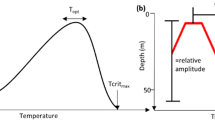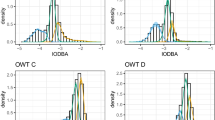Abstract
We tracked six individuals of three shark species, the shortfin mako, Isurus oxyrinchus, great white, Carcharodon carcharias, and blue, Prionace glauca, near the submarine canyon off La Jolla, southern California during the summers of 1995 and 1997. The duration of tracking ranged from 2 to 38 h per shark. The mode of travel differed in one respect among species. The rate of movement of the endothermic species, the mako and white shark, exceeded that of the ectothermic species, the blue shark. Similarities among species were more common. Firstly, individuals of all three species swam in a directional manner. Secondly, individuals constantly moved up and down in the water column, exhibiting oscillatory or yo-yo swimming. Thirdly, members of the three species swam at the surface for prolonged periods. Finally, the movements of the mako and white sharks were at times loosely associated with bottom topography. We discuss the various adaptive advantages that have been proposed for these behavioral patterns. Oscillatory swimming has been attributed to the following: (1) heating the body in the warm surface waters after swimming in cold, deep water, (2) alternating between two strata of water, one carrying chemical information as to its source, and deriving a direction to that stratum's origin, (3) conserving energy by quickly propelling oneself upward with many tail beats and slowly gliding downward with few beats, and (4) descending to where magnetic gradients are steeper, more perceptible, and useful to guide migratory movements. At the surface, an individual would be able to swim in a straight line by using following features as a reference: (1) celestial bodies, (2) polarized light, or (3) the earth's main dipole field. Furthermore, an individual would conserve energy because of the greater ease to maintaining a warm body in the heated surface waters.
Similar content being viewed by others
References cited
Antonelis, G.A., M.S. Lowry, C.H. Fiscus, B.S. Stewart & R.L. DeLong. 1994. Diet of the northern elephant seal. pp. 211–223. In: B.J. Le Boenf & R.M. Laws (ed.) Elephant Seals: Population Ecology, Behavior, and Physiology, University of California Press, Berkeley.
Block, B.A., D.T. Booth & F.G. Carey. 1992. Depth and temperature of the blue marlin, Makaira nigricans, observed by acoustic telemetry. Mar. Biol. 114: 175–183.
Block, B.A., J.E. Keen, B. Castillo, H. Dewar, E.V. Freund, D.J. Marcinek, R.W. Brill & C. Farwell. 1997. Environmental preferences of yellowfin tuna (Thunnus albacares) at the northern extent of its range. Mar. Biol. 130: 119–132.
Brill, R.W., B.A. Block, C.H. Boggs, K.A. Bigelow, E.V. Freund & D.J. Marcinek. 1999. Horizontal movements and depth distribution of large adult yellowfin tuna (Thunnus albacares) near the Hawaiian Islands, recorded using ultrasonic telemetry: implications for the physiological ecology of pelagic fishes. Mar. Biol. 113: 395–408.
Carey, F.G. 1973. Fishes with warm bodies. Sci. Amer. 228: 36–44.
Carey, F.G. & J.V. Scharold. 1990. Movements of blue shark (Prionace glauca) in depth and course. Mar. Biol. 106: 329–342.
Døving, K.B., H. Westerberg & P.B. Johnsen. 1985. Role of olfaction in the behavioral and neuronal responses of Atlantic salmon, Salmo salar, to hydrographic stratification. Can. J. Fish. Aquat. Sci. 42: 1658–1667.
Elsasser, W.M. 1946. Induction effects in terrestrial magnetism. Theor. Phys. Rev. 69: 106–116.
Graham, J.B. & D.R. Diener. 1978. Comparative morphology of the central heat exchangers in the skipjacks Katsuwonus and Euthynnus. pp. 113–134. In: G.D. Sharp & A.E. Dizon (ed.) The Physiological Ecology of Tunas, Academic Press, New York.
Groot, C. 1965. On the orientation of young sockeye salmon (Oncorhynchus nerka) during their seaward migration out of lakes. Anim. Behav. Suppl. 14: 1–198.
Gruber, S.H. 1982. Role of the lemon shark, Negaprion brevirostris (Poey) as a predator in the tropical marine environment: a multidisciplinary study. Florida Scientist 45: 46–75.
Gruber, S.H., D.R. Nelson & J.F. Morrissey. 1988. Patterns of activity and space utilization of lemon sharks, Negaprion brevirostris, in a shallow Bahamian lagoon. Bull. Mar. Sci. 43: 61–76.
Hasler, A.D. 1966. Underwater guideposts. University of Wisconsin Press, Madison. 155 pp.
Hawryshyn, C.W., M.G. Arnold, E. Bowering & R.L. Cole. 1990. Spatial orientation of rainbowtrout to plane-polarized light: the ontogeny of E-vector discrimination and spectral sensitivity characteristics. J. Comp. Physiol. A. 166: 565–574.
Holland, K., R. Brill & R.K.C. Chang. 1990a. Horizontal and verticalmovements of Pacific blue marlin captured and released using sportfishing gear. U.S. Fish. Bull. 88: 397–402.
Holland, K., R.W. Brill & R.K.C. Chang. 1990b. Horizontal and vertical movements of yellowfin and bigeye tuna associated with fish aggregating devices. U.S. Fish. Bull. 88: 493–507.
Holland, K.N., R.W. Brill, R.K.C. Chang, J.R. Sibert & D.A. Fournier. 1992. Physiological and behavioural thermoregulation in bigeye tuna (Thunnus obesus). Nature 358: 410–411.
Holts, D.B. & D.W. Bedford. 1993. Horizontal and vertical movements of the shortfin mako shark, Isurus oxyrinchus, in the Southern California Bight. Aust. J. Mar. Freshwater Res. 44: 901–909.
Hunter, J.R., A.W. Argue, W.H. Bayliff, A.E. Dizon, A. Fontenaeau, D. Goodman & G.R. Seckel. 1986. The dynamics of tuna movements: an evaluation of past and future research. FAO Fish. Tech. Paper 277: 1–78.
Klimley, A.P. 1993. Highly directional swimming by the scalloped hammerhead sharks, Sphyrna lewini, and subsurface irradiance, temperature, bathymetry, and geomagnetic field. Mar. Biol. 117: 1–22.
Klimley, A.P., S.B. Butler, D.R. Nelson & A.T. Stull. 1988. Diel movements of scalloped hammerhead sharks (Sphyrna lewini Griffith and Smith) to and from a seamount in the Gulf of California. J. Fish Biol. 33: 751–761.
Klimley, A.P. & D.R. Nelson. 1984. Diel movement patterns of the scalloped hammerhead shark (Sphyrna lewini) in relation to El Bajo Espiritu Santo: a refuging central-position social system. Behavioral Ecology and Sociobiology 15: 45–54.
Landesman, J.G. 1984. Horizontal and vertical movements and seasonal populational shifts in the blue shark, Prionace glauca, near Sanata Catalina Island, California. M.S. Thesis, California State University, Long Beach. 79 pp.
Le Boeuf, B.J. & R.M. Laws (ed.). 1994. Elephant seals: population ecology, behavior, and physiology. University of California Press, Berkeley. 414 pp.
Loyacano, H.A., J.A. Chappel & S.A. Gauthreaux. 1977. Sun-compass orientation in largemouth bass, Micropterus salmoides. Trans. Amer. Fish. Soc. 106: 77–79.
Macdonald, K.C., S.P. Miller, S.P. Huestis & F.N. Spiess. 1980. Three-dimensional modeling of a magnetic reversal boundary from inversion of two deep measurements. J. Geophys. Res. 85: 3670–3680.
Nelson, D.R. 1990. Telemetry studies of sharks: a review, with applications in resource management. pp. 239–253. In: H.L. Pratt, Jr., S.H. Gruber & T. Taniuchi (ed.) Elasmobranchs as Living Resources, NOAA Tech. Rept. NMFS 90.
Nelson, D.R., J.N. McKibben, W.R. Strong, Jr., C.G. Lowe, J.A. Sisneros, D.M. Schroeder & R.J. Lavenburg. 1997. An acoustic tracking of a megamouth shark, Megachasma pelagios: a crepuscular vertical migrator. Env. Biol. Fish. 49: 389–399.
Novales-Flamarique, I. & C.W. Hawryshyn. 1992. Spectral characteristics of salmonid migratory routes from southern Vancouver Island (British Columbia). Can. J. Fish. Aquat. Sci. 50: 1706–1716.
Press, F. & R. Siever. 1986. Earth. W.H. Freeman and Company, New York. 656 pp.
Sciarrotta, T.C. & D.R. Nelson. 1977. Diel behavior of the blue shark, Prionace glauca, near Santa Catalina Island, California. U.S. Fish. Bull. 75: 519–528.
Skiles, D.D. 1985. The geomagnetic field: its nature, history, and biological relevance. pp. 43–102. In: J.L Kirschvink, D.S. Jones & B.J. MacFadden (ed.) Magnetite Biomineralization and Magnetoreception in Organisms, Plenum Press, New York.
Strong, W.R., R.C. Murphy, B.D. Bruce & D.R. Nelson. 1992. Movements and associated observations of bait-attracted white sharks, Carcharodon carcharias: a preliminary report. Aust. J. Mar. Freshwater Res. 43: 13–20.
Tricas, T.C., L.R. Taylor & G. Naftel. 1981. Diel behavior of the tiger shark, Galeocerdo cuvier, at French Frigate Shoals, Hawaiian Islands. Copeia 1981: 904–908.
Wallcott, C. & R.P. Green. 1974. Orientation of homing pigeons is altered by a change in the direction of an applied magnetic field. Science 184: 180–182.
Weihs, D. 1973. Mechanically efficient swimming techniques for fish with negative buoyancy. J. Mar. Res. 31: 194–209.
Weihs, D., R.S. Keyes & D.M. Stalls. 1981. Voluntary swimming speeds of two species of large carcharhinid sharks. Copeia 1981: 219–222.
Westerberg, H. 1984. The orientation of fish and the vertical stratification at fine-and micro-structure scales. pp. 179–203. In: J.D. McCleave, G.P. Arnold, J.J. Dodson & W.H. Neill (ed.) Mechanisms of Migration in Fishes, Plenum Press, New York.
Westerberg, H. 1982a. Ultrasonic tracking of Atlantic salmon (Salmo salar L.)-I. Movements in coastal regions. Rep. Inst. Freshw. Res. Drottningholm 60: 81–101.
Westerberg, H. 1982b. Ultrasonic tracking of Atlantic salmon (Salmo salar L.)-II. Swimming depth and temperature stratification. Rep. Inst. Freshw. Res. Drottningholm 60: 102–120.
Williams, T.M., R.W. Davis, L.A. Fuiman, J. Francis, B.J. Le Boeuf, M. Horning, J. Calambokidis & D.A. Croll. 2000. Sink or swim: strategies for cost-efficient diving by marine mammals. Science 133–136.
Winn, H.E., M. Salmon & N. Roberts. 1964. Sun-orientation by parrot fishes. Ethology 21: 798–812.
Author information
Authors and Affiliations
Rights and permissions
About this article
Cite this article
Peter Klimley, A., Beavers, S.C., Curtis, T.H. et al. Movements and Swimming Behavior of Three Species of Sharks in La Jolla Canyon, California. Environmental Biology of Fishes 63, 117–135 (2002). https://doi.org/10.1023/A:1014200301213
Issue Date:
DOI: https://doi.org/10.1023/A:1014200301213




